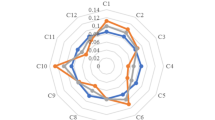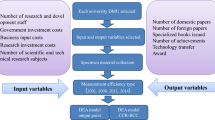Abstract
There are 79.3% of incubators in university campus. These university incubators are funded and directed by the government in Taiwan. However, each incubator has given limited resources and geographical limitation. To overcome these issues, district alliance is become a very good way. So that the total public expenditures required for incubators can be reduced. This paper uses the viewpoint of operation research for this issue. Base on the methodology of data envelopment analysis (DEA) and heuristic techniques, this research develops an evaluation method for university incubators to select their district partners to improve the potential average efficiency, integrating resources and enhancing performance. Realistic data are collected from Taiwan government for case study. The results indicate that the average efficiency of whole university incubators increases from 0.8000559 to 0.8962224 by our approach. The research analyses by slack variable analysis to assess the maximum operational performance as well. This research can effectively integrate the multi-resources of all university incubators, enhance competitive advantage and provides practical suggestions for government authorities when district alliance is assessed and initiated.
Similar content being viewed by others
References
Avkiran N.K.: Investigating technical and scale efficiencies of Australian Universities through data envelopment analysis. Socioecon. Plann. Sci. 35(1), 57–80 (2001)
Banker R.D., Charnes A., Cooper W.W.: Some models for estimating technical and scale inefficiencies in data envelopment analysis. Manage. Sci. 30(9), 1078–1092 (1984)
Bhattacharyya A., Lovell C.A.K., Sahay P.: The impact of liberalization on the productive difference of Indian commercial banks. Eur. J. Oper. Res. 98(2), 332–345 (1997)
Camanho A.S., Dyson R.G.: Cost efficiency measurement with price uncertainty: a DEA application to bank branch assessments. Eur. J. Oper. Res. 161(2), 432–446 (2005)
Chang D.S., Lo L.K.: Measuring the relative efficiency of a firm’s ability to achieve organizational benefits after ISO certification. Total Qual. Manag. Bus. Excell. 16(1), 57–69 (2005)
Chapple W., Lockett A., Siegel D., Wright M.: Assessing the relative performance of U.K. university technology transfer offices: parametric and non-parametric evidence. Res. Policy 2(3), 369–384 (2005)
Charnes A., Cooper W.W., Rhodes E.: Measuring the efficiency of decision making units. Eur. J. Oper. Res. 2(6), 429–444 (1978)
Chen M.C., Yang T., Yen C.T.: Investigating the value of information sharing in multi-echelon supply chains. Qual. Quant. 41(3), 497–511 (2007)
Co H.C., Chew K.S.: Performance and R&D expenditures in American and Japanese manufacturing firms. Int. J. Prod. Res. 35(12), 3333–3348 (1997)
Cook W.D., Zhu J.: Output deterioration with input reduction in data envelopment analysis. IIE Trans. 35(3), 309–320 (2003)
Cooper W.W., Seiford L.M., Tone K.: Data Envelopment Analysis—A Comprehensive Text with Models, Applications, References and DEA-Solver Software. Springer Inc, New York (2000)
Durand R., Vargas V.: Ownership, organization, and private firms’ efficient use of resources. Strateg. Manag. J. 24(7), 667–675 (2003)
Farrell M.J.: The measurement of productive efficiency. J. R. Stat. Soc. 120(3), 253–281 (1957)
Forker L.B., Mendez D., Hershauer J.C.: Total quality management in the supply chain: what is its impact on performance?. Int. J. Prod. Res. 35(6), 1681–1702 (1997)
Golany B., Roll Y.: An application procedure for data envelopment analysis. Omega 17(3), 237–250 (1989)
Homburg C.: Using data envelopment analysis to benchmark activities. Int. J. Prod. Econ. 73(1), 51–58 (2001)
Lee S., Lee K., Kang I.: Efficiency analysis of controls in EDI applications. Inf. Manage. 42(3), 425–439 (2005)
Luo X., Donthu N.: Assessing advertising media spending inefficiencies in generating sales. J. Bus. Res. 58(1), 28–36 (2005)
Mota S., Benzecry J.H., Qassim R.Y.: A model for the application of data envelopment analysis (DEA) in activity-based management (ABM). Int. J. Technol. Manag. 17(7–8), 861–868 (1999)
Small and Medium Enterprise Administration: Year Report of Incubators. Taiwan Government, Taipei (2007)
Wang, C.N., Wang, C.H.: A DEA application model for merger and acquisition in high-tech business. In: Proceedings of IEEE international conference on engineering management, IEEE (2005)




